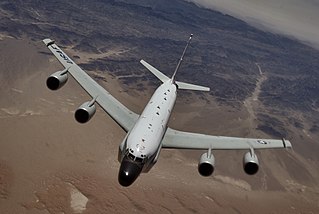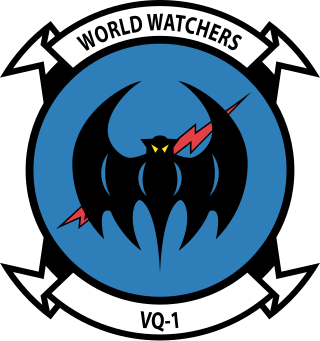
The Lockheed S-3 Viking is a four-crew, twin-engine turbofan-powered jet aircraft designed and produced by the American aerospace manufacturer Lockheed Corporation. Because of its characteristic sound, it was nicknamed the "War Hoover" after the vacuum cleaner brand.

In military telecommunications, electronic support (ES) or electronic support measures (ESM) gather intelligence through passive "listening" to electromagnetic radiations of military interest. They are an aspect of electronic warfare involving actions taken under direct control of an operational commander to detect, intercept, identify, locate, record, and/or analyze sources of radiated electromagnetic energy for the purposes of immediate threat recognition or longer-term operational planning. Thus, electronic support provides a source of information required for decisions involving electronic protection (EP), electronic attack (EA), avoidance, targeting, and other tactical employment of forces. Electronic support data can be used to produce signals intelligence (SIGINT), communications intelligence (COMINT) and electronics intelligence (ELINT).

The Lockheed P-3 Orion is a four-engined, turboprop anti-submarine and maritime surveillance aircraft developed for the United States Navy and introduced in the 1960s. Lockheed based it on the L-188 Electra commercial airliner; it is easily distinguished from the Electra by its distinctive tail stinger or "MAD" boom, used for the magnetic anomaly detection (MAD) of submarines.

Naval Air Station Whidbey Island (NASWI) is a naval air station of the United States Navy located on two pieces of land near Oak Harbor, on Whidbey Island, in Island County, Washington.

The Beechcraft C-12 Huron is the military designation for a series of twin-engine turboprop aircraft based on the Beechcraft Super King Air and Beechcraft 1900. C-12 variants are used by the United States Air Force, Army, Navy and Marine Corps. These aircraft are used for various duties, including embassy support, medical evacuation, as well as passenger and light cargo transport. Some aircraft are modified with surveillance systems for various missions, including the Cefly Lancer, Beechcraft RC-12 Guardrail and Project Liberty programs.

The Douglas A-3 Skywarrior is a jet-powered strategic bomber that was developed and produced by the Douglas Aircraft Company. It was designed by Douglas on behalf of the United States Navy, which sought a carrier-capable strategic bomber. In July 1949, Douglas was awarded the contract to produce its design, having bested eight other aircraft companies' submissions. Unlike rival designs, which had aimed for a 100,000 lb (45,000 kg) maximum take-off weight, the Skywarrior was developed for a 68,000 lb (31,000 kg) take-off weight, facilitating its use from the navy's existing Midway-class aircraft carriers. Large portions of the aircraft were produced by the Westinghouse Electric Corporation, including its early Westinghouse J40 turbojet engines, which failed to meet promises and were replaced by the rival Pratt & Whitney J57 engine by mid-1953. On 28 October 1952, the prototype XA3D-1 performed the type's maiden flight.

The Lockheed P-2 Neptune is a maritime patrol and anti-submarine warfare (ASW) aircraft. It was developed for the US Navy by Lockheed to replace the Lockheed PV-1 Ventura and PV-2 Harpoon, and was replaced in turn by the Lockheed P-3 Orion. Designed as a land-based aircraft, the Neptune never made a carrier landing, but a small number were converted and deployed as carrier-launched, stop-gap nuclear bombers that would have to land on shore or ditch. The type was successful in export, and saw service with several armed forces.

The Martin P4M Mercator was a maritime reconnaissance aircraft built by the Glenn L. Martin Company. The Mercator was an unsuccessful contender for a United States Navy requirement for a long-range maritime patrol bomber, with the Lockheed P2V Neptune chosen instead. It saw a limited life as a long-range electronic reconnaissance aircraft. Its most unusual feature was that it was powered by a combination of piston engines and turbojets, the latter being in the rear of the engine nacelles.

The Northrop Grumman MQ-4C Triton is an American high-altitude long endurance unmanned aerial vehicle (UAV) developed for and flown by the United States Navy as a surveillance aircraft. Together with its associated ground control station, it is an unmanned aircraft system (UAS). Developed under the Broad Area Maritime Surveillance (BAMS) program, the Triton is intended to provide real-time intelligence, surveillance and reconnaissance missions (ISR) over vast ocean and coastal regions, continuous maritime surveillance, conduct search and rescue missions, and to complement the Boeing P-8 Poseidon maritime patrol aircraft.

The Lockheed EC-121 Warning Star was an American airborne early warning and control radar surveillance aircraft operational in the 1950s in both the United States Navy (USN) and United States Air Force (USAF).

No. 10 Squadron is a Royal Australian Air Force (RAAF) signals intelligence (SIGINT) squadron based at RAAF Base Edinburgh, South Australia. It is part of No. 92 Wing RAAF. The squadron was formed in 1939 as a maritime patrol unit. It saw active service during the Second World War, conducting anti-submarine operations and patrols from bases in the United Kingdom until it disbanded in late 1945. It was re-formed in Australia in 1949 and since then has contributed to Australia's East Timor intervention, and has been deployed to the Middle East as part of the War on Terrorism and the 2003 Gulf War. Most recently it now has a signals intelligence mission.

The Lockheed AP-3C Orion is a variant of the P-3 Orion used by the Royal Australian Air Force (RAAF) for tasks such as naval fleet support, maritime surveillance, search and survivor supply and anti-surface and anti-submarine warfare. The 18 AP-3C Orions were upgraded from P-3Cs between 1997 and 2005, with the program taking three years longer than expected due to systems integration problems. All 18 AP-3C Orions are operated by No. 92 Wing which is based at RAAF Base Edinburgh in South Australia. Aircraft from the wing have seen service as part of Australian Defence Force operations in Australia, South East Asia and the Middle East.

Signals intelligence operational platforms are employed by nations to collect signals intelligence, which is intelligence-gathering by interception of signals, whether between people or between machines, or mixtures of the two. As sensitive information is often encrypted, signals intelligence often involves the use of cryptanalysis. However, traffic analysis—the study of who is signalling whom and in what quantity—can often produce valuable information, even when the messages themselves cannot be decrypted.

The Kawasaki P-2J is a maritime patrol and ASW aircraft developed for the Japan Maritime Self-Defense Force. A turboprop-powered version of the radial-engined P-2 Neptune, the P-2J was developed as an alternative to buying the larger and more expensive P-3 Orion, which would eventually replace the P-2J in the 1980s.

VX-20, Air Test and Evaluation Squadron Twenty, is a United States Navy air test and evaluation squadron based at Naval Air Station Patuxent River, Maryland.
VQ-11, nicknamed the Bandits, was a Fleet Air Reconnaissance Squadron of the U.S. Naval Air Reserve. Originally established at Naval Air Station WillowGrove, Pennsylvania and later moved to NAS Brunswick, Maine, were there establishment ceremony was held on 1 July 1997 and disestablished less than three years later, on 31 March 2000. It was the Naval Air Reserve's first and only Fleet Air Reconnaissance Squadron, but it did not actually perform reconnaissance. Instead, it simulated hostile electronic warfare threats by radar jamming and communications jamming during fleet training exercises.

Fleet Air Reconnaissance Squadron 1 (VQ-1) is an aviation unit of the United States Navy established on 1 June 1955. Its role is aerial reconnaissance and signals intelligence. The squadron is nicknamed the "World Watchers" and is based at NAS Whidbey Island, flying Lockheed EP-3E Aries II aircraft.

Patrol Squadron 30 (VP-30) is a maritime patrol squadron of the United States Navy, established on 30 June 1960. It is based at Naval Air Station Jacksonville, Florida.

Fleet Air Reconnaissance Squadron VQ-2, also known as "Batmen" and later "Sandeman," was an air reconnaissance squadron of the United States Navy, established on 1 September 1955 and based at NAS Whidbey Island, previously at NAVSTA Rota, Spain, flying both Douglas EA-3B Skywarrior and Lockheed EP-3E Aries aircraft until 1991 and then strictly EP-3E aircraft until 2012. The squadron was disestablished on 22 May 2012.





















